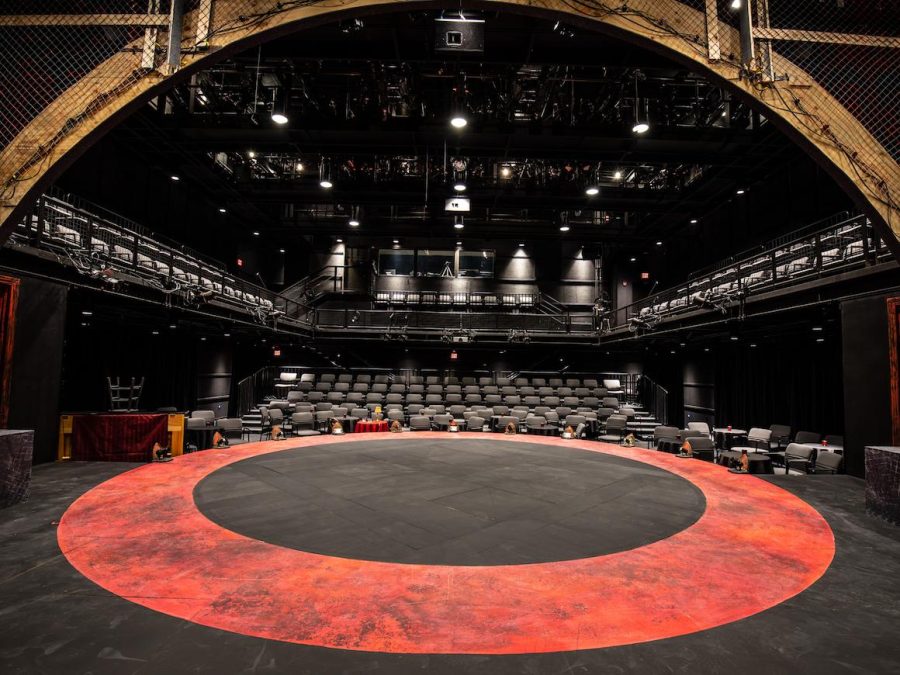Oberlin Students Receive Award for Theater Renovation Project
The Irene and Alan Wurtzel Theater is one of Oberlin’s many performance spaces. Students designed a theoretical renovation for the Hall Auditorium, located within the same complex, for the United States Institute for Theatre Technology conference.
On March 15, two Oberlin College students traveled to St. Louis for the annual United States Institute for Theater Technology Conference. The conference was a three-day-long event featuring educational sessions, an expo floor with master’s degree programs, companies currently hiring, and companies selling products related to theater technology.
While College first-year Andrew McCraken and College second-year Nelson Gutsch happily took advantage of all that the conference had to offer, their primary purpose for attending was to participate in the biannual American Society of Theater Consultation USITT Venue Renovation Challenge. This took place on Friday, March 17. To begin the day, the students met with their ASTC consultant Howard Glickman, OC ’92.
“He’s a theater consultant professionally and has done many jobs that have actually executed plans like this, so he had a lot of insight on what we needed to be thinking about and how to make this project successful,” Gutsch said.
Clearly the students’ hard work and Glickman’s assistance paid off, as Oberlin College placed second in the challenge, winning the USITT Director’s Award. McCraken and Gutsch were part of a group of six students who worked on the renovation project. This consisted of College second-year Ansel Mills, College second-year Leanne O’Donnell, College first-year Charley Davis, and College second-year Nova Gomez. Gutsch, the leader of the group, described the project as “an initial pitch meeting” for a theoretical theater renovation. Students were tasked with finding a theater space on campus, investigating it, and proposing hypothetical improvements.
The Oberlin team chose Hall Auditorium. McCraken explained that “it was built in the ʼ50s, and it was built as a concert and recital hall, so it’s designed for acoustics.”
This makes it difficult to use theatrically, leading the group to realize its great potential for renovations. Gutsch detailed the five different aspects of their proposed improvements. The first three proposals were purely for the benefit of productions. The group wanted to raise the roof over the stage, so curtains could be brought all the way out without being in sight of the audience. Additionally, they would fix lighting positions over the audience for better aesthetics and easier access. They also wanted to add a sound booth to the back of the house. The two renovations take into account broader concerns. Because Hall Auditorium was built before the Americans with Disabilities Act, it isn’t compliant with current accessibility codes. The group also wanted to focus on sustainability.
“[We switched] over our lighting to LED to draw less power [and then reused] some of that power and putting it into motorized fly lines over the stage to bring in scenery and curtains,” Gutsch said.“[We left] space for a new HVAC system and any other mechanical systems we would need in the future … to be able to incorporate other environmentally sustainable systems.”
McCraken pointed out the unique nature of theater architecture.
“It’s totally different from other types of architecture just because of the nature of a theatrical space — there’s completely different code compliance requirements, totally different needs,” he said. “By doing this project, I have now learned a whole other part of how to see a space and how to see its capabilities and drawbacks.”
While Gutsch recognized the specificity of theater architecture, he noted that on the other hand, it has broader applications as well.
“It’s super useful in pretty much everything else I do,ˮ he said. “Getting … knowledge of how to build a set can also translate to a certain extent into practical knowledge. Learning about theater architecture; a lot of it is niche and specific to performance spaces, but a lot of it is applicable to any architecture.”
Theater technology can be a foundation for a number of jobs and careers as well. Gutsch is a Theater major, and McCraken intends to declare a Theater major. Both of them have a technical focus. They both offered praise for the ability to pursue theater technology at Oberlin, despite the fact that Oberlin isn’t particularly well known for that program. He said that this semester alone, he’s been able to do lighting design, sound design, sound mixing, run crew, and electrical work.
“Oberlin has a huge amount of theater kids and actors who want to do their own shows, and not a lot of tech kids,” McCracken said. “[With 16 theater productions, there is] a huge amount of opportunity to just do design. By doing, you’re learning.”
Gutsch had similar feedback, pointing out that the Kander Lab Series is student-run and that there are a number of organizations on campus that support technology, such as Concert Sound or the Student Lighting & Sound Association. Additionally, he wanted to make clear that any student interested in learning about theater technology at Oberlin should feel free to reach out to him and that he would be more than happy to help them get involved.










